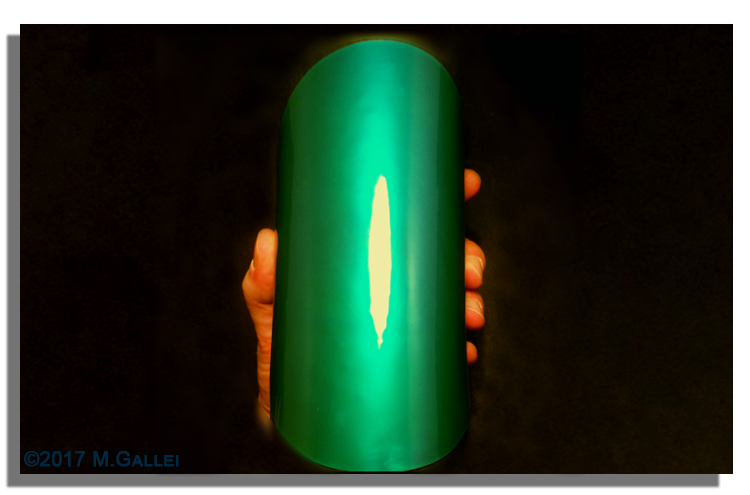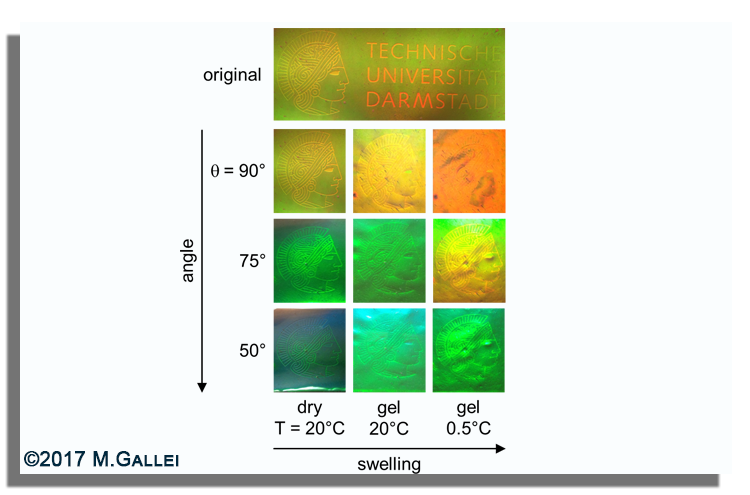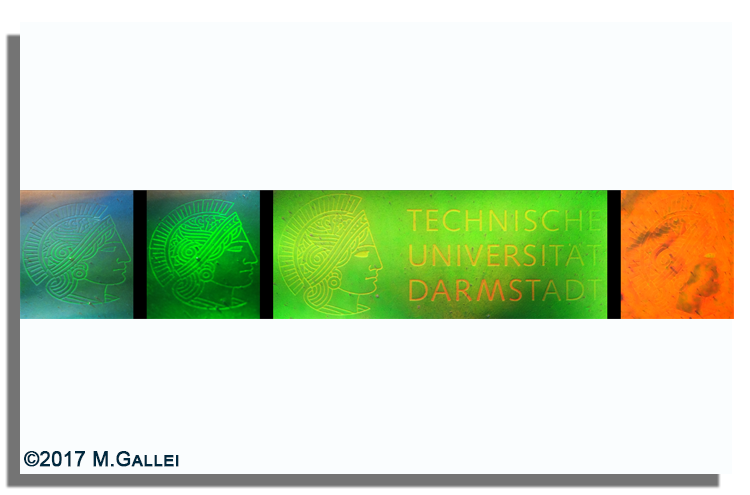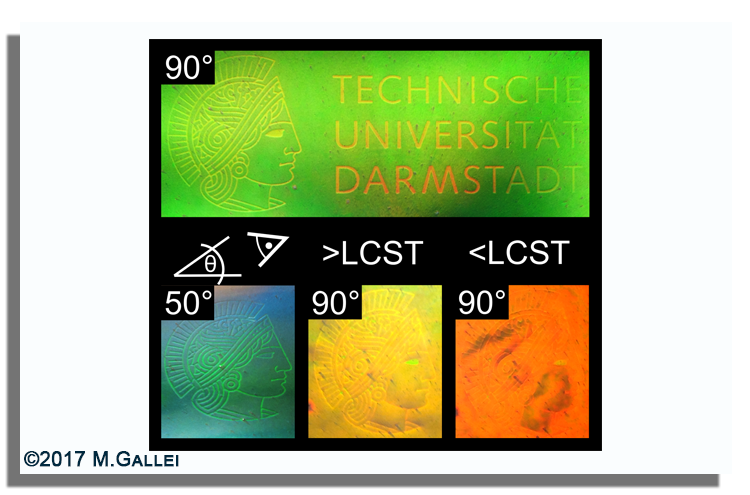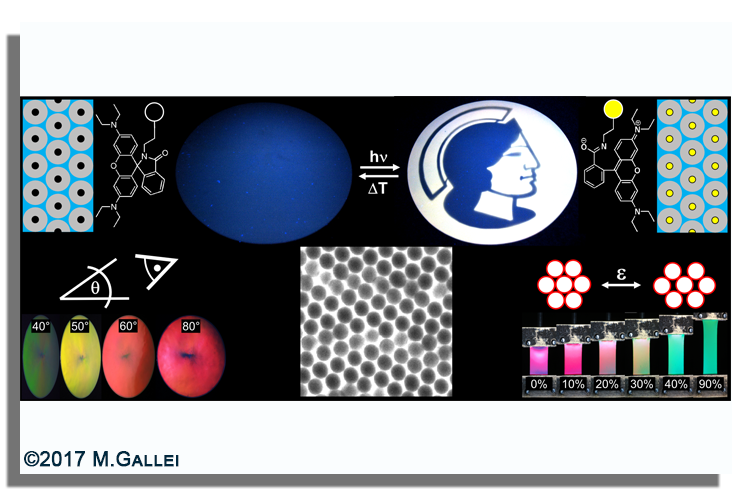Photonic band gap materials have attracted a great deal of attention as potential candidates for various optoelectronic applications. With easily accessible monodisperse colloids, such materials can be prepared by an inexpensive and convenient bottom-up process.
A good optical performance with iridescent reflection colors, caused by Bragg diffraction of visible light, is obtained after colloidal crystallization. This optical feature for 3D photonic band gap materials has been forecast in the pioneering works of John and Yablonovitch.
So-called elastomeric polymer opals, where monodisperse beads with diameters typically in the range of 200−350 nm are embedded in a soft matrix, can be fabricated to yield reversible stretch-tunable films showing remarkable color changes due to a bend or stretch modification of the 111 (200) plane spacing. The lattice distances in these soft opal films and hence the reflected colors have been varied, e.g., as a function of an applied voltage, as well as other external triggers such as organic solvents, pH value, or transition metals are well-known.
A responsive core/shell structure or polymer matrix led to fascinating tunable materials which are definitely interesting candidates for, e.g., sensing devices or as actuation systems. In our group the promising melt-shear organization technique based on shearing the melt of hard core/soft shell particles for the production of highly ordered elastomeric polymer opal films is used. This technique enables the formation of large-area films which reflect spectrally distinct colors due to Bragg reflection from the fcc lattice as function of the incident angle.
Due to their elastomeric feature, these films also show remarkable color changes due to a precisely controlled lattice deformation. Moreover, opal films can be stimuli-responsive and the stop-band of the material can be influenced by several external triggers, e.g. light, solvents, temperature, ionic strength, redox chemistry or by applying an electrical field. Inverse opal structures featuring an outstanding structural porosity have attracted enormous attention in the field of photonic bandgap materials and – due to their adjustable porosity – for many other applications comprising membranes and electrode materials.
In this regard a plethora of nanostructures comprising spheres, cylinders, lamellae, co-continuous, and other structures as well as porous structures could be obtained. Nowadays, there are already many applications for block copolymers ranging for instance from the fields of nanolithography to drug delivery to separation technologies.
Exemplary references:
- Vowinkel, S.; Schäfer, C. G.; Cherkashinin, G.; Fasel, C.; Roth, F.; Liu, N.; Dietz, C.; Ionescu, E.; Gallei, M. 3D-ordered carbon materials by melt-shear organization for tailor-made hybrid core–shell polymer particle architectures. J. Mater. Chem. C 2016, 4, 3976-3986.
- Scheid, D.; Stock, D.; Winter, T.; Gutmann, T.; Dietz, C.; Gallei, M. The pivotal step of nanoparticle functionalization for the preparation of functional and magnetic hybrid opal films. J. Mater. Chem. C 2016, 4, (11), 2187-2196.
- Schäfer, C. G.; Winter, T.; Heidt, S.; Dietz, C.; Ding, T.; Baumberg, J. J.; Gallei, M. Smart polymer inverse-opal photonic crystal films by melt-shear organization for hybrid core–shell architectures. J. Mater. Chem. C 2015, 3, (10), 2204-2214.
- Ding, T.; Cao, G.; Schäfer, C. G.; Zhao, Q.; Gallei, M.; Smoukov, S. K.; Baumberg, J. J. Revealing Invisible Photonic Inscriptions: Images from Strain. ACS applied materials & interfaces 2015, 7, (24), 13497-13502.
- Scheid, D.; Lederle, C.; Vowinkel, S.; Schäfer, C. G.; Stühn, B.; Gallei, M. Redox- and mechano-chromic response of metallopolymer-based elastomeric colloidal crystal films. J. Mater. Chem. C 2014, 2, 2583-2590.
- Schäfer, C. G.; Vowinkel, S.; Hellmann, G. P.; Herdt, T.; Contiu, C.; Schneider, J. J.; Gallei, M. A polymer based and template-directed approach towards functional multidimensional microstructured organic/inorganic hybrid materials. J. Mater. Chem. C 2014, 2, 7960-7975.
- Schäfer, C. G.; Lederle, C.; Zentel, K.; Stühn, B.; Gallei, M. Utilising Stretch-Tunable Thermochromic Elastomeric Opal Films as Novel Reversible Switchable Photonic Materials. Macromol. Rap. Commun. 2014, 35, (21), 1852-1860.
- Schäfer, C. G.; Viel, B.; Hellmann, G. P.; Rehahn, M.; Gallei, M. Thermo-cross-linked Elastomeric Opal Films. ACS applied materials & interfaces 2013, 5, 10623-10632.
- Schäfer, C. G.; Smolin, D. A.; Hellmann, G. P.; Gallei, M. Fully reversible shape transition of soft spheres in elastomeric polymer opal films. Langmuir 2013, 29, 11275-11283.
- Schäfer, C. G.; Gallei, M.; Zahn, J. T.; Engelhardt, J.; Hellmann, G. P.; Rehahn, M. Reversible Light-, Thermo-, and Mechano-Responsive Elastomeric Polymer Opal Films. Chem. Mater. 2013, 25, 2309-2318.

